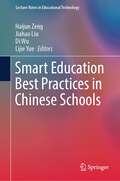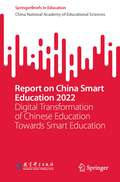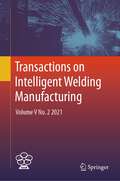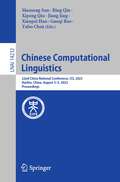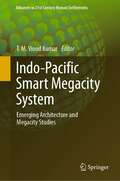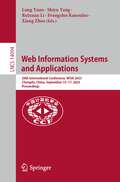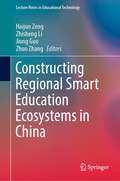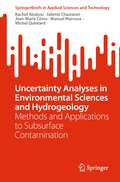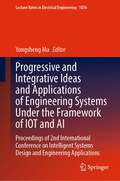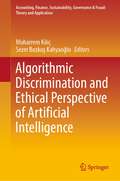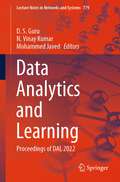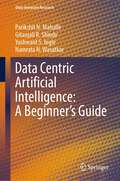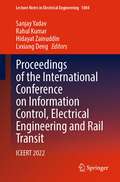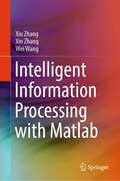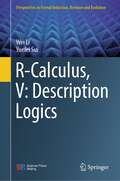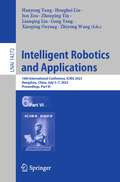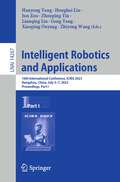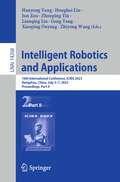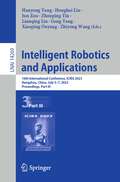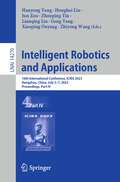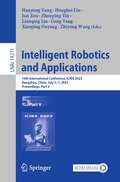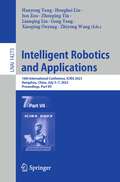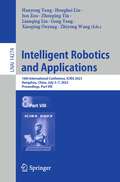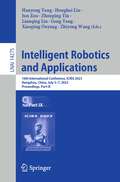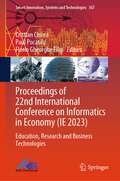- Table View
- List View
Smart Education Best Practices in Chinese Schools (Lecture Notes in Educational Technology)
by Haijun Zeng Jiahao Liu Di Wu Lijie YueThis book presents 28 practical case studies in detail and 49 case studies in brief. The collection of these case studies focuses on one or more aspects of exploration and practice on the following topics: smart campus and smart classroom, resource construction and sharing, new teaching mode, comprehensive quality evaluation of students, teacher professional development, application of teaching platform and tool, innovative application of online learning space, collaborative education, and school management and services. The selection and evaluation criteria of the case studies on school practice mainly include concept and implementation, effectiveness and characteristics, innovation and demonstration, and expression and structure. This book helps readers gain a rich understanding of the diverse innovative implementation of smart education in Chinese schools and inspires smart education development in schools in other countries.
Report on China Smart Education 2022: Digital Transformation of Chinese Education Towards Smart Education (SpringerBriefs in Education)
by China National Academy of Edu., SciencesThis book aims to reflect the digital transformation of Chinese education toward smart education comprehensively and accurately. It is the first systematic summary of the progress of smart education in China. The book believes that smart education is a new education form in the digital era and is essentially distinct from education forms in the industrial era. This new education form is innovative in five dimensions. First is the new core concept. Smart education is not only a concrete action concerning people’s well-being, but also a vital strategy concerning national plans. Through technology empowerment and data drive, it empowers educational reform in all aspects, systematically constructs a new relationship between education and society, provides suitable education for each learner, and makes the aptitude-based teaching that we have been dreaming of for thousands of years a reality. For the first time in history, smart education helps to reach the full alignment between individual development and societal development. Second is the new system structure. Smart education will break through the boundaries of school education, drive the diversified combination of various education types, resources, and elements, promote the collaboration of school, family, and society in education, and build a high-quality, individualized lifelong learning system that is available for anyone anywhere anytime. Third is the new teaching paradigm. Smart education will integrate physical, social, and digital spaces to create new learning scenarios and promote human–technology integration, and cultivate cross-grade, cross-class, and cross-discipline learning communities across time and space to organically combine large-scale education with individualized cultivation. Fourth is the new educational content. Smart education will focus on developing all-round education, establishing digital knowledge graphs based on systematic logics of knowledge points, and innovating content presentation methods to make learning a wonderful experience and help learners develop higher-order thinking skills, comprehensive innovation capability, and lifelong learning ability. Fifth is the new education governance. With data governance at the core and digital intelligence technology as the driver, smart education will boost the holistic reengineering of education administration and business processes and enhance the modernization of the education governance system and governance capacity. This book is intended for teachers, education administrators, education policymakers, education researchers, and parents concerned about education innovation and development, as well as people from all walks of life who have aspirations for the education industry. It can also serve as a reference for international organizations and education research institutions of all countries to promote the joint exploration of the development path of smart education and create a better future for the world’s mutual development through educational reform.
Transactions on Intelligent Welding Manufacturing: Volume V No. 2 2021 (Transactions on Intelligent Welding Manufacturing)
by Shanben Chen Yuming Zhang Zhili FengThe primary aim of this volume is to provide researchers and engineers from both academic and industry with up-to-date coverage of new results in the field of robotic welding, intelligent systems and automation. The book is mainly based on papers selected from the 2022 International Conference on Robotic Welding, Intelligence and Automation (RWIA’2022) in Shanghai and Lanzhou, China. The articles show that the intelligentized welding manufacturing (IWM) is becoming an inevitable trend with the intelligentized robotic welding as the key technology. The volume is divided into four logical parts: Intelligent Techniques for Robotic Welding, Sensing of Arc Welding Processing, Modeling and Intelligent Control of Welding Processing, as well as Intelligent Control and its Applications in Engineering.
Chinese Computational Linguistics: 22nd China National Conference, CCL 2023, Harbin, China, August 3–5, 2023, Proceedings (Lecture Notes in Computer Science #14232)
by Maosong Sun Bing Qin Xipeng Qiu Jiang Jing Xianpei Han Gaoqi Rao Yubo ChenThis book constitutes the refereed proceedings of the 22nd China National Conference on Chinese Computational Linguistics, CCL 2023, Harbin, China, August 3–5, 2023. The 82 full papers included in this book were carefully reviewed and selected from 278 submissions. They were organized in topical sections as follows: Fundamental Theory and Methods of Computational Linguistics, Information Retrieval, Dialogue and Question Answering, Text Generation, Dialogue and Summarization, Knowledge Graph and Information Extraction, Machine Translation and Multilingual Information Processing, Language Resource and Evaluation, Pre-trained Language Models, Social Computing and Sentiment Analysis, NLP Applications.
Indo-Pacific Smart Megacity System: Emerging Architecture and Megacity Studies (Advances in 21st Century Human Settlements)
by T. M. Vinod KumarThis book is an in-depth study of the Indo-Pacific region for effective interventions in the megacities system. First, based on several criteria, the region is identified as homogeneous country groupings of diversity, a multi-polar spatial system, and as program regions of QUAD and I2U2 for action programs and investment transcending many nations but mostly the ocean space of the Indo-Pacific, connecting all megacities sub-regions spatially and functionally. Then, the megacities with problems and prospects for economic integration are studied from the point of view of regional economics and international trade, and finally, the rural–urban interface with case studies of selected countries is presented. Prospects of systems of megacities and individual megacities for regional economies are designed. Existing interconnections through rail, air, and ocean of megacity systems, their capacity, performance, and potential are analyzed for emerging issues. International trade among the megacity systems/countries with emerging issues and barriers are presented. The mobility of money, goods, and services among the systems of megacities is analyzed. Rule-based diplomacy and other emerging options are discussed to sustain the above calls for a study of the Security of the Indo-Pacific region. Finally, the emerging architecture for megacity system governance is also presented.Out of 21 megacities in the Indo-Pacific, an in-depth study of a few in India and Japan in the Indo-Pacific region for effective economic interventions in the megacities system at the city level was studied. COVID-19 has affected most of the countries in the Indo-Pacific. With a contraction of GDP and a GDP growth rate negative, the number below the poverty level increased. Foreign Direct Investment is not forthcoming in any of these countries. Job creation becomes a priority in addition to public health concerns connected with COVID-19.
Web Information Systems and Applications: 20th International Conference, WISA 2023, Chengdu, China, September 15–17, 2023, Proceedings (Lecture Notes in Computer Science #14094)
by Long Yuan Shiyu Yang Ruixuan Li Evangelos Kanoulas Xiang ZhaoThis book constitutes the proceedings of the 20th International Conference on Web Information Systems and Applications, WISA 2023, held in Chengdu, China, in September 2023. The 43 full papers and 9 short papers presented in this book were carefully reviewed and selected from 213 submissions. The papers are grouped in topical sections on Data Mining and Knowledge Discovery, Recommender Systems, Natural Language Processing, Security, Privacy and Trust, Blockchain, Parallel and Distributed Systems and Database for Artificial Intelligence..
Constructing Regional Smart Education Ecosystems in China (Lecture Notes in Educational Technology)
by Haijun Zeng Zhisheng Li Jiong Guo Zhuo ZhangThis book enriches the understanding of regional smart education in China and promotes sharing of smart education case studies in China and abroad. It presents 46 case studies selected from a total of 644 case studies collected nationwide in China. These selected case studies focus on regional construction, research findings, and solutions. The case studies on regional construction mainly focus on the sustainable development mechanism of regional smart education. The research findings case studies showcase research results produced by research teams and individuals, which involve theories, models, technologies, practical investigations, or international comparisons related to smart education. Lastly, the solution case studies are technical solutions provided by enterprises for the development of smart education, which include application scenarios, methods, and effects in regions or schools around smart educational equipment, platforms, networks, tools, resources, or integrated solutions.
Uncertainty Analyses in Environmental Sciences and Hydrogeology: Methods and Applications to Subsurface Contamination (SpringerBriefs in Applied Sciences and Technology)
by Rachid Ababou Juliette Chastanet Jean-Marie Côme Manuel Marcoux Michel QuintardThis book highlights several methods and quantitative implementations of both probabilistic and fuzzy-based approaches to uncertainty quantification and uncertainty propagation through environmental subsurface pollution models with uncertain input parameters. The book focuses on methods as well as applications in hydrogeology, soil hydrology, groundwater contamination, and related areas (e.g., corrosion of nuclear waste canisters). The methods are illustrated for a broad spectrum of models, from non-differential I/O models to complex PDE solvers, including a novel 3D quasi-analytical model of contaminant transport, and a site-specific computer model of dissolved contaminant migration from a DNAPL (Dense Non Aqueous Phase Liquid) pollution source.
Progressive and Integrative Ideas and Applications of Engineering Systems Under the Framework of IOT and AI: Proceedings of 2nd International Conference on Intelligent Systems Design and Engineering Applications (Lecture Notes in Electrical Engineering #1076)
by Yongsheng MaThis volume of proceedings contains peer reviewed papers presented at 2023 International Conference on Intelligent Systems Design and Engineering Applications which was held in Okayama, Japan, May 12-14, 2023 (ISDEA2023). There are five major sessions covered in this book, including 1) Theory and Application of Artificial Intelligence Technologies in Industry; 2) System Design and Data Analysis within the Context of Internet of Things (IOT) ; 3) System Automation, Control, and Robots; 4) Smart Product Design and Integrated Manufacturing and 5) Sensors, Transducers and detection technology. This conference provides an idea-exchange and discussion platform for the world's engineers and academia to share cutting-edge information, address the hottest issue in intelligent systems design and engineering applications, explore new technologies, exchange and build upon ideas.
Algorithmic Discrimination and Ethical Perspective of Artificial Intelligence (Accounting, Finance, Sustainability, Governance & Fraud: Theory and Application)
by Muharrem Kılıç Sezer Bozkuş KahyaoğluThis book delves into the complex intersection between artificial intelligence and human rights violations, shedding light on the far-reaching implications within the framework of discrimination and the pivotal role equality bodies play in combatting these issues. Through a collaborative effort between the Human Rights and Equality Institution of Türkiye (HREIT) and Hasan Kalyoncu University, the groundbreaking "International Symposium on the Effects of Artificial Intelligence in the Context of the Prohibition of Discrimination" took place on March 30, 2022, in Gaziantep. This book is the outcome of this symposium, bringing attention to the alarming issues of "bias and discrimination" prevalent in the application of artificial intelligence. With a commitment to Sustainable Development Goal 8.10 of safeguarding human rights in the digital realm and countering the adverse effects of artificial intelligence, this work is an essential contribution to the Human Rights Action Plan. Comprising an array of insightful chapters, this book offers an in-depth exploration of artificial intelligence technologies, encompassing a broad spectrum of topics ranging from data protection to algorithmic discrimination, the deployment of artificial intelligence in criminal proceedings to combating hate speech, and from predictive policing to meta-surveillance. It aims to serve as a call to action, urging societies and policymakers to acknowledge the potential threats posed by AI and recognize the need for robust legislative frameworks and ethical principles to ensure that international standards on human rights are upheld in the face of technological advancements.
Data Analytics and Learning: Proceedings of DAL 2022 (Lecture Notes in Networks and Systems #779)
by D. S. Guru N. Vinay Kumar Mohammed JavedThis book presents new theories and working models in the areas of data analytics and learning. The papers included in this volume were presented at the second International Conference on Data Analytics and Learning (DAL 2022), which was organized by the Department of Computer Science & Engineering, Alva’s Institute of Engineering & Technology, Moodbidri, Mangalore, Karnataka, India in association with the Department of Studies in Computer Science, University of Mysore, Mysuru, Karnataka, India. The areas covered include pattern recognition, image processing, deep learning, computer vision, data analytics, machine learning, artificial intelligence, and intelligent systems.
Data Centric Artificial Intelligence: A Beginner’s Guide (Data-Intensive Research)
by Parikshit N. Mahalle Gitanjali R. Shinde Yashwant S. Ingle Namrata N. WasatkarThis book discusses the best research roadmaps, strategies, and challenges in data-centric approach of artificial intelligence (AI) in various domains. It presents comparative studies of model-centric and data-centric AI. It also highlights different phases in data-centric approach and data-centric principles. The book presents prominent use cases of data-centric AI. It serves as a reference guide for researchers and practitioners in academia and industry.
Proceedings of the International Conference on Information Control, Electrical Engineering and Rail Transit: ICEERT 2022 (Lecture Notes in Electrical Engineering #1084)
by Sanjay Yadav Rahul Kumar Hidayat Zainuddin Lvxiang DengThis book includes the peer-reviewed proceedings of the 2nd International Conference on Information Control, Electrical Engineering, and Rail Transit (ICEERT 2022). This book provides the advanced research results of transportation and covers the main research fields of information control, traffic information engineering, and control, intelligent transit, logistics, etc. This book aims to promote a new green and intelligent mode of rail transit between scholars from the top universities, research centers, and high-tech enterprises around the world, which is beneficial to researchers and practitioners in mechanical engineering.
Intelligent Information Processing with Matlab
by Xiu Zhang Xin Zhang Wei WangThis book is a comprehensive collection of technologies and methods on intelligent information processing, which includes artificial neural network, fuzzy logic, and evolutionary computing. It also introduces the latest research directions and progress in intelligent information processing, such as transfer learning through convolutional neural network, time series prediction, clustering based on fuzzy neural network, test and evaluation of the traveling salesman problem, test and evaluation of continuous optimization problem, and more. This book promotes the development and application of intelligent information processing technology in the field of computational intelligence, effectively improving the intersection and integration of intelligent information processing methods. Researchers in computational intelligence and artificial intelligence technology, as well as teachers, students, and others interested in the subject, will benefit from this book.
R-Calculus, V: Description Logics (Perspectives in Formal Induction, Revision and Evolution)
by Wei Li Yuefei SuiThis book series consists of two parts, decidable description logics and undecidable description logics. It gives the R-calculi for description logics. This book offers a rich blend of theory and practice. It is suitable for students, researchers and practitioners in the field of logic.
Intelligent Robotics and Applications: 16th International Conference, ICIRA 2023, Hangzhou, China, July 5–7, 2023, Proceedings, Part VI (Lecture Notes in Computer Science #14272)
by Huayong Yang Honghai Liu Jun Zou Zhouping Yin Lianqing Liu Geng Yang Xiaoping Ouyang Zhiyong WangThe 9-volume set LNAI 14267-14275 constitutes the proceedings of the 16th International Conference on Intelligent Robotics and Applications, ICIRA 2023, which took place in Hangzhou, China, during July 5–7, 2023.The 413 papers included in these proceedings were carefully reviewed and selected from 630 submissions. They were organized in topical sections as follows:Part I: Human-Centric Technologies for Seamless Human-Robot Collaboration; Multimodal Collaborative Perception and Fusion; Intelligent Robot Perception in Unknown Environments; Vision-Based Human Robot Interaction and Application.Part II: Vision-Based Human Robot Interaction and Application; Reliable AI on Machine Human Reactions; Wearable Sensors and Robots; Wearable Robots for Assistance, Augmentation and Rehabilitation of Human Movements; Perception and Manipulation of Dexterous Hand for Humanoid Robot.Part III: Perception and Manipulation of Dexterous Hand for Humanoid Robot; Medical Imaging for Biomedical Robotics; Advanced Underwater Robot Technologies; Innovative Design and Performance Evaluation of Robot Mechanisms; Evaluation of Wearable Robots for Assistance and Rehabilitation; 3D Printing Soft Robots.Part IV: 3D Printing Soft Robots; Dielectric Elastomer Actuators for Soft Robotics; Human-like Locomotion and Manipulation; Pattern Recognition and Machine Learning for Smart Robots.Part V: Pattern Recognition and Machine Learning for Smart Robots; Robotic Tactile Sensation, Perception, and Applications; Advanced Sensing and Control Technology for Human-Robot Interaction; Knowledge-Based Robot Decision-Making and Manipulation; Design and Control of Legged Robots.Part VI: Design and Control of Legged Robots; Robots in Tunnelling and Underground Space; Robotic Machining of Complex Components; Clinically Oriented Design in Robotic Surgery and Rehabilitation; Visual and Visual-Tactile Perception for Robotics.Part VII: Visual and Visual-Tactile Perception for Robotics; Perception, Interaction, and Control of Wearable Robots; Marine Robotics and Applications; Multi-Robot Systems for Real World Applications; Physical and Neurological Human-Robot Interaction.Part VIII: Physical and Neurological Human-Robot Interaction; Advanced Motion Control Technologies for Mobile Robots; Intelligent Inspection Robotics; Robotics in Sustainable Manufacturing for Carbon Neutrality; Innovative Design and Performance Evaluation of Robot Mechanisms.Part IX: Innovative Design and Performance Evaluation of Robot Mechanisms; Cutting-Edge Research in Robotics.
Intelligent Robotics and Applications: 16th International Conference, ICIRA 2023, Hangzhou, China, July 5–7, 2023, Proceedings, Part I (Lecture Notes in Computer Science #14267)
by Huayong Yang Honghai Liu Jun Zou Zhouping Yin Lianqing Liu Geng Yang Xiaoping Ouyang Zhiyong WangThe 9-volume set LNAI 14267-14275 constitutes the proceedings of the 16th International Conference on Intelligent Robotics and Applications, ICIRA 2023, which took place in Hangzhou, China, during July 5–7, 2023.The 413 papers included in these proceedings were carefully reviewed and selected from 630 submissions. They were organized in topical sections as follows:Part I: Human-Centric Technologies for Seamless Human-Robot Collaboration; Multimodal Collaborative Perception and Fusion; Intelligent Robot Perception in Unknown Environments; Vision-Based Human Robot Interaction and Application.Part II: Vision-Based Human Robot Interaction and Application; Reliable AI on Machine Human Reactions; Wearable Sensors and Robots; Wearable Robots for Assistance, Augmentation and Rehabilitation of Human Movements; Perception and Manipulation of Dexterous Hand for Humanoid Robot.Part III: Perception and Manipulation of Dexterous Hand for Humanoid Robot; Medical Imaging for Biomedical Robotics; Advanced Underwater Robot Technologies; Innovative Design and Performance Evaluation of Robot Mechanisms; Evaluation of Wearable Robots for Assistance and Rehabilitation; 3D Printing Soft Robots.Part IV: 3D Printing Soft Robots; Dielectric Elastomer Actuators for Soft Robotics; Human-like Locomotion and Manipulation; Pattern Recognition and Machine Learning for Smart Robots.Part V: Pattern Recognition and Machine Learning for Smart Robots; Robotic Tactile Sensation, Perception, and Applications; Advanced Sensing and Control Technology for Human-Robot Interaction; Knowledge-Based Robot Decision-Making and Manipulation; Design and Control of Legged Robots.Part VI: Design and Control of Legged Robots; Robots in Tunnelling and Underground Space; Robotic Machining of Complex Components; Clinically Oriented Design in Robotic Surgery and Rehabilitation; Visual and Visual-Tactile Perception for Robotics.Part VII: Visual and Visual-Tactile Perception for Robotics; Perception, Interaction, and Control of Wearable Robots; Marine Robotics and Applications; Multi-Robot Systems for Real World Applications; Physical and Neurological Human-Robot Interaction.Part VIII: Physical and Neurological Human-Robot Interaction; Advanced Motion Control Technologies for Mobile Robots; Intelligent Inspection Robotics; Robotics in Sustainable Manufacturing for Carbon Neutrality; Innovative Design and Performance Evaluation of Robot Mechanisms.Part IX: Innovative Design and Performance Evaluation of Robot Mechanisms; Cutting-Edge Research in Robotics.
Intelligent Robotics and Applications: 16th International Conference, ICIRA 2023, Hangzhou, China, July 5–7, 2023, Proceedings, Part II (Lecture Notes in Computer Science #14268)
by Huayong Yang Honghai Liu Jun Zou Zhouping Yin Lianqing Liu Geng Yang Xiaoping Ouyang Zhiyong WangThe 9-volume set LNAI 14267-14275 constitutes the proceedings of the 16th International Conference on Intelligent Robotics and Applications, ICIRA 2023, which took place in Hangzhou, China, during July 5–7, 2023. The 413 papers included in these proceedings were carefully reviewed and selected from 630 submissions. They were organized in topical sections as follows: Part I: Human-Centric Technologies for Seamless Human-Robot Collaboration; Multimodal Collaborative Perception and Fusion; Intelligent Robot Perception in Unknown Environments; Vision-Based Human Robot Interaction and Application. Part II: Vision-Based Human Robot Interaction and Application; Reliable AI on Machine Human Reactions; Wearable Sensors and Robots; Wearable Robots for Assistance, Augmentation and Rehabilitation of Human Movements; Perception and Manipulation of Dexterous Hand for Humanoid Robot. Part III: Perception and Manipulation of Dexterous Hand for Humanoid Robot; Medical Imaging for Biomedical Robotics; Advanced Underwater Robot Technologies; Innovative Design and Performance Evaluation of Robot Mechanisms; Evaluation of Wearable Robots for Assistance and Rehabilitation; 3D Printing Soft Robots. Part IV: 3D Printing Soft Robots; Dielectric Elastomer Actuators for Soft Robotics; Human-like Locomotion and Manipulation; Pattern Recognition and Machine Learning for Smart Robots. Part V: Pattern Recognition and Machine Learning for Smart Robots; Robotic Tactile Sensation, Perception, and Applications; Advanced Sensing and Control Technology for Human-Robot Interaction; Knowledge-Based Robot Decision-Making and Manipulation; Design and Control of Legged Robots. Part VI: Design and Control of Legged Robots; Robots in Tunnelling and Underground Space; Robotic Machining of Complex Components; Clinically Oriented Design in Robotic Surgery and Rehabilitation; Visual and Visual-Tactile Perception for Robotics. Part VII: Visual and Visual-Tactile Perception for Robotics; Perception, Interaction, and Control of Wearable Robots; Marine Robotics and Applications; Multi-Robot Systems for Real World Applications; Physical and Neurological Human-Robot Interaction. Part VIII: Physical and Neurological Human-Robot Interaction; Advanced Motion Control Technologies for Mobile Robots; Intelligent Inspection Robotics; Robotics in Sustainable Manufacturing for Carbon Neutrality; Innovative Design and Performance Evaluation of Robot Mechanisms. Part IX: Innovative Design and Performance Evaluation of Robot Mechanisms; Cutting-Edge Research in Robotics.
Intelligent Robotics and Applications: 16th International Conference, ICIRA 2023, Hangzhou, China, July 5–7, 2023, Proceedings, Part III (Lecture Notes in Computer Science #14269)
by Huayong Yang Honghai Liu Jun Zou Zhouping Yin Lianqing Liu Geng Yang Xiaoping Ouyang Zhiyong WangThe 9-volume set LNAI 14267-14275 constitutes the proceedings of the 16th International Conference on Intelligent Robotics and Applications, ICIRA 2023, which took place in Hangzhou, China, during July 5–7, 2023.The 413 papers included in these proceedings were carefully reviewed and selected from 630 submissions. They were organized in topical sections as follows:Part I: Human-Centric Technologies for Seamless Human-Robot Collaboration; Multimodal Collaborative Perception and Fusion; Intelligent Robot Perception in Unknown Environments; Vision-Based Human Robot Interaction and Application.Part II: Vision-Based Human Robot Interaction and Application; Reliable AI on Machine Human Reactions; Wearable Sensors and Robots; Wearable Robots for Assistance, Augmentation and Rehabilitation of Human Movements; Perception and Manipulation of Dexterous Hand for Humanoid Robot.Part III: Perception and Manipulation of Dexterous Hand for Humanoid Robot; Medical Imaging for Biomedical Robotics; Advanced Underwater Robot Technologies; Innovative Design and Performance Evaluation of Robot Mechanisms; Evaluation of Wearable Robots for Assistance and Rehabilitation; 3D Printing Soft Robots.Part IV: 3D Printing Soft Robots; Dielectric Elastomer Actuators for Soft Robotics; Human-like Locomotion and Manipulation; Pattern Recognition and Machine Learning for Smart Robots.Part V: Pattern Recognition and Machine Learning for Smart Robots; Robotic Tactile Sensation, Perception, and Applications; Advanced Sensing and Control Technology for Human-Robot Interaction; Knowledge-Based Robot Decision-Making and Manipulation; Design and Control of Legged Robots.Part VI: Design and Control of Legged Robots; Robots in Tunnelling and Underground Space; Robotic Machining of Complex Components; Clinically Oriented Design in Robotic Surgery and Rehabilitation; Visual and Visual-Tactile Perception for Robotics.Part VII: Visual and Visual-Tactile Perception for Robotics; Perception, Interaction, and Control of Wearable Robots; Marine Robotics and Applications; Multi-Robot Systems for Real World Applications; Physical and Neurological Human-Robot Interaction.Part VIII: Physical and Neurological Human-Robot Interaction; Advanced Motion Control Technologies for Mobile Robots; Intelligent Inspection Robotics; Robotics in Sustainable Manufacturing for Carbon Neutrality; Innovative Design and Performance Evaluation of Robot Mechanisms.Part IX: Innovative Design and Performance Evaluation of Robot Mechanisms; Cutting-Edge Research in Robotics.
Intelligent Robotics and Applications: 16th International Conference, ICIRA 2023, Hangzhou, China, July 5–7, 2023, Proceedings, Part IV (Lecture Notes in Computer Science #14270)
by Huayong Yang Honghai Liu Jun Zou Zhouping Yin Lianqing Liu Geng Yang Xiaoping Ouyang Zhiyong WangThe 9-volume set LNAI 14267-14275 constitutes the proceedings of the 16th International Conference on Intelligent Robotics and Applications, ICIRA 2023, which took place in Hangzhou, China, during July 5–7, 2023.The 413 papers included in these proceedings were carefully reviewed and selected from 630 submissions. They were organized in topical sections as follows:Part I: Human-Centric Technologies for Seamless Human-Robot Collaboration; Multimodal Collaborative Perception and Fusion; Intelligent Robot Perception in Unknown Environments; Vision-Based Human Robot Interaction and Application.Part II: Vision-Based Human Robot Interaction and Application; Reliable AI on Machine Human Reactions; Wearable Sensors and Robots; Wearable Robots for Assistance, Augmentation and Rehabilitation of Human Movements; Perception and Manipulation of Dexterous Hand for Humanoid Robot.Part III: Perception and Manipulation of Dexterous Hand for Humanoid Robot; Medical Imaging for Biomedical Robotics; Advanced Underwater Robot Technologies; Innovative Design and Performance Evaluation of Robot Mechanisms; Evaluation of Wearable Robots for Assistance and Rehabilitation; 3D Printing Soft Robots.Part IV: 3D Printing Soft Robots; Dielectric Elastomer Actuators for Soft Robotics; Human-like Locomotion and Manipulation; Pattern Recognition and Machine Learning for Smart Robots.Part V: Pattern Recognition and Machine Learning for Smart Robots; Robotic Tactile Sensation, Perception, and Applications; Advanced Sensing and Control Technology for Human-Robot Interaction; Knowledge-Based Robot Decision-Making and Manipulation; Design and Control of Legged Robots.Part VI: Design and Control of Legged Robots; Robots in Tunnelling and Underground Space; Robotic Machining of Complex Components; Clinically Oriented Design in Robotic Surgery and Rehabilitation; Visual and Visual-Tactile Perception for Robotics.Part VII: Visual and Visual-Tactile Perception for Robotics; Perception, Interaction, and Control of Wearable Robots; Marine Robotics and Applications; Multi-Robot Systems for Real World Applications; Physical and Neurological Human-Robot Interaction.Part VIII: Physical and Neurological Human-Robot Interaction; Advanced Motion Control Technologies for Mobile Robots; Intelligent Inspection Robotics; Robotics in Sustainable Manufacturing for Carbon Neutrality; Innovative Design and Performance Evaluation of Robot Mechanisms.Part IX: Innovative Design and Performance Evaluation of Robot Mechanisms; Cutting-Edge Research in Robotics.
Intelligent Robotics and Applications: 16th International Conference, ICIRA 2023, Hangzhou, China, July 5–7, 2023, Proceedings, Part V (Lecture Notes in Computer Science #14271)
by Huayong Yang Honghai Liu Jun Zou Zhouping Yin Lianqing Liu Geng Yang Xiaoping Ouyang Zhiyong WangThe 9-volume set LNAI 14267-14275 constitutes the proceedings of the 16th International Conference on Intelligent Robotics and Applications, ICIRA 2023, which took place in Hangzhou, China, during July 5–7, 2023.The 413 papers included in these proceedings were carefully reviewed and selected from 630 submissions. They were organized in topical sections as follows:Part I: Human-Centric Technologies for Seamless Human-Robot Collaboration; Multimodal Collaborative Perception and Fusion; Intelligent Robot Perception in Unknown Environments; Vision-Based Human Robot Interaction and Application.Part II: Vision-Based Human Robot Interaction and Application; Reliable AI on Machine Human Reactions; Wearable Sensors and Robots; Wearable Robots for Assistance, Augmentation and Rehabilitation of Human Movements; Perception and Manipulation of Dexterous Hand for Humanoid Robot.Part III: Perception and Manipulation of Dexterous Hand for Humanoid Robot; Medical Imaging for Biomedical Robotics; Advanced Underwater Robot Technologies; Innovative Design and Performance Evaluation of Robot Mechanisms; Evaluation of Wearable Robots for Assistance and Rehabilitation; 3D Printing Soft Robots.Part IV: 3D Printing Soft Robots; Dielectric Elastomer Actuators for Soft Robotics; Human-like Locomotion and Manipulation; Pattern Recognition and Machine Learning for Smart Robots.Part V: Pattern Recognition and Machine Learning for Smart Robots; Robotic Tactile Sensation, Perception, and Applications; Advanced Sensing and Control Technology for Human-Robot Interaction; Knowledge-Based Robot Decision-Making and Manipulation; Design and Control of Legged Robots.Part VI: Design and Control of Legged Robots; Robots in Tunnelling and Underground Space; Robotic Machining of Complex Components; Clinically Oriented Design in Robotic Surgery and Rehabilitation; Visual and Visual-Tactile Perception for Robotics.Part VII: Visual and Visual-Tactile Perception for Robotics; Perception, Interaction, and Control of Wearable Robots; Marine Robotics and Applications; Multi-Robot Systems for Real World Applications; Physical and Neurological Human-Robot Interaction.Part VIII: Physical and Neurological Human-Robot Interaction; Advanced Motion Control Technologies for Mobile Robots; Intelligent Inspection Robotics; Robotics in Sustainable Manufacturing for Carbon Neutrality; Innovative Design and Performance Evaluation of Robot Mechanisms.Part IX: Innovative Design and Performance Evaluation of Robot Mechanisms; Cutting-Edge Research in Robotics.
Intelligent Robotics and Applications: 16th International Conference, ICIRA 2023, Hangzhou, China, July 5–7, 2023, Proceedings, Part VII (Lecture Notes in Computer Science #14273)
by Huayong Yang Honghai Liu Jun Zou Zhouping Yin Lianqing Liu Geng Yang Xiaoping Ouyang Zhiyong WangThe 9-volume set LNAI 14267-14275 constitutes the proceedings of the 16th International Conference on Intelligent Robotics and Applications, ICIRA 2023, which took place in Hangzhou, China, during July 5–7, 2023.The 413 papers included in these proceedings were carefully reviewed and selected from 630 submissions. They were organized in topical sections as follows:Part I: Human-Centric Technologies for Seamless Human-Robot Collaboration; Multimodal Collaborative Perception and Fusion; Intelligent Robot Perception in Unknown Environments; Vision-Based Human Robot Interaction and Application.Part II: Vision-Based Human Robot Interaction and Application; Reliable AI on Machine Human Reactions; Wearable Sensors and Robots; Wearable Robots for Assistance, Augmentation and Rehabilitation of Human Movements; Perception and Manipulation of Dexterous Hand for Humanoid Robot.Part III: Perception and Manipulation of Dexterous Hand for Humanoid Robot; Medical Imaging for Biomedical Robotics; Advanced Underwater Robot Technologies; Innovative Design and Performance Evaluation of Robot Mechanisms; Evaluation of Wearable Robots for Assistance and Rehabilitation; 3D Printing Soft Robots.Part IV: 3D Printing Soft Robots; Dielectric Elastomer Actuators for Soft Robotics; Human-like Locomotion and Manipulation; Pattern Recognition and Machine Learning for Smart Robots.Part V: Pattern Recognition and Machine Learning for Smart Robots; Robotic Tactile Sensation, Perception, and Applications; Advanced Sensing and Control Technology for Human-Robot Interaction; Knowledge-Based Robot Decision-Making and Manipulation; Design and Control of Legged Robots.Part VI: Design and Control of Legged Robots; Robots in Tunnelling and Underground Space; Robotic Machining of Complex Components; Clinically Oriented Design in Robotic Surgery and Rehabilitation; Visual and Visual-Tactile Perception for Robotics.Part VII: Visual and Visual-Tactile Perception for Robotics; Perception, Interaction, and Control of Wearable Robots; Marine Robotics and Applications; Multi-Robot Systems for Real World Applications; Physical and Neurological Human-Robot Interaction.Part VIII: Physical and Neurological Human-Robot Interaction; Advanced Motion Control Technologies for Mobile Robots; Intelligent Inspection Robotics; Robotics in Sustainable Manufacturing for Carbon Neutrality; Innovative Design and Performance Evaluation of Robot Mechanisms.Part IX: Innovative Design and Performance Evaluation of Robot Mechanisms; Cutting-Edge Research in Robotics.
Intelligent Robotics and Applications: 16th International Conference, ICIRA 2023, Hangzhou, China, July 5–7, 2023, Proceedings, Part VIII (Lecture Notes in Computer Science #14274)
by Huayong Yang Honghai Liu Jun Zou Zhouping Yin Lianqing Liu Geng Yang Xiaoping Ouyang Zhiyong WangThe 9-volume set LNAI 14267-14275 constitutes the proceedings of the 16th International Conference on Intelligent Robotics and Applications, ICIRA 2023, which took place in Hangzhou, China, during July 5–7, 2023.The 413 papers included in these proceedings were carefully reviewed and selected from 630 submissions. They were organized in topical sections as follows:Part I: Human-Centric Technologies for Seamless Human-Robot Collaboration; Multimodal Collaborative Perception and Fusion; Intelligent Robot Perception in Unknown Environments; Vision-Based Human Robot Interaction and Application.Part II: Vision-Based Human Robot Interaction and Application; Reliable AI on Machine Human Reactions; Wearable Sensors and Robots; Wearable Robots for Assistance, Augmentation and Rehabilitation of Human Movements; Perception and Manipulation of Dexterous Hand for Humanoid Robot.Part III: Perception and Manipulation of Dexterous Hand for Humanoid Robot; Medical Imaging for Biomedical Robotics; Advanced Underwater Robot Technologies; Innovative Design and Performance Evaluation of Robot Mechanisms; Evaluation of Wearable Robots for Assistance and Rehabilitation; 3D Printing Soft Robots.Part IV: 3D Printing Soft Robots; Dielectric Elastomer Actuators for Soft Robotics; Human-like Locomotion and Manipulation; Pattern Recognition and Machine Learning for Smart Robots.Part V: Pattern Recognition and Machine Learning for Smart Robots; Robotic Tactile Sensation, Perception, and Applications; Advanced Sensing and Control Technology for Human-Robot Interaction; Knowledge-Based Robot Decision-Making and Manipulation; Design and Control of Legged Robots.Part VI: Design and Control of Legged Robots; Robots in Tunnelling and Underground Space; Robotic Machining of Complex Components; Clinically Oriented Design in Robotic Surgery and Rehabilitation; Visual and Visual-Tactile Perception for Robotics.Part VII: Visual and Visual-Tactile Perception for Robotics; Perception, Interaction, and Control of Wearable Robots; Marine Robotics and Applications; Multi-Robot Systems for Real World Applications; Physical and Neurological Human-Robot Interaction.Part VIII: Physical and Neurological Human-Robot Interaction; Advanced Motion Control Technologies for Mobile Robots; Intelligent Inspection Robotics; Robotics in Sustainable Manufacturing for Carbon Neutrality; Innovative Design and Performance Evaluation of Robot Mechanisms.Part IX: Innovative Design and Performance Evaluation of Robot Mechanisms; Cutting-Edge Research in Robotics.
Intelligent Robotics and Applications: 16th International Conference, ICIRA 2023, Hangzhou, China, July 5–7, 2023, Proceedings, Part IX (Lecture Notes in Computer Science #14275)
by Huayong Yang Honghai Liu Jun Zou Zhouping Yin Lianqing Liu Geng Yang Xiaoping Ouyang Zhiyong WangThe 9-volume set LNAI 14267-14275 constitutes the proceedings of the 16th International Conference on Intelligent Robotics and Applications, ICIRA 2023, which took place in Hangzhou, China, during July 5–7, 2023.The 413 papers included in these proceedings were carefully reviewed and selected from 630 submissions. They were organized in topical sections as follows:Part I: Human-Centric Technologies for Seamless Human-Robot Collaboration; Multimodal Collaborative Perception and Fusion; Intelligent Robot Perception in Unknown Environments; Vision-Based Human Robot Interaction and Application.Part II: Vision-Based Human Robot Interaction and Application; Reliable AI on Machine Human Reactions; Wearable Sensors and Robots; Wearable Robots for Assistance, Augmentation and Rehabilitation of Human Movements; Perception and Manipulation of Dexterous Hand for Humanoid Robot.Part III: Perception and Manipulation of Dexterous Hand for Humanoid Robot; Medical Imaging for Biomedical Robotics; Advanced Underwater Robot Technologies; Innovative Design and Performance Evaluation of Robot Mechanisms; Evaluation of Wearable Robots for Assistance and Rehabilitation; 3D Printing Soft Robots.Part IV: 3D Printing Soft Robots; Dielectric Elastomer Actuators for Soft Robotics; Human-like Locomotion and Manipulation; Pattern Recognition and Machine Learning for Smart Robots.Part V: Pattern Recognition and Machine Learning for Smart Robots; Robotic Tactile Sensation, Perception, and Applications; Advanced Sensing and Control Technology for Human-Robot Interaction; Knowledge-Based Robot Decision-Making and Manipulation; Design and Control of Legged Robots.Part VI: Design and Control of Legged Robots; Robots in Tunnelling and Underground Space; Robotic Machining of Complex Components; Clinically Oriented Design in Robotic Surgery and Rehabilitation; Visual and Visual-Tactile Perception for Robotics.Part VII: Visual and Visual-Tactile Perception for Robotics; Perception, Interaction, and Control of Wearable Robots; Marine Robotics and Applications; Multi-Robot Systems for Real World Applications; Physical and Neurological Human-Robot Interaction.Part VIII: Physical and Neurological Human-Robot Interaction; Advanced Motion Control Technologies for Mobile Robots; Intelligent Inspection Robotics; Robotics in Sustainable Manufacturing for Carbon Neutrality; Innovative Design and Performance Evaluation of Robot Mechanisms.Part IX: Innovative Design and Performance Evaluation of Robot Mechanisms; Cutting-Edge Research in Robotics.
Proceedings of 22nd International Conference on Informatics in Economy: Education, Research and Business Technologies (Smart Innovation, Systems and Technologies #367)
by Cristian Ciurea Paul Pocatilu Florin Gheorghe FilipThis book includes high-quality research papers presented at 22nd International Conference on Informatics in Economy (IE 2023), which is held in Bucharest, Romania, during May 2023. This book covers research results in business informatics and related computer science topics, such as IoT, mobile-embedded and multimedia solutions, e-society, enterprise and business solutions, databases and big data, artificial intelligence, data mining and machine learning, quantitative economics.
